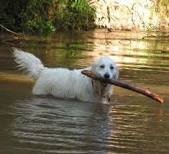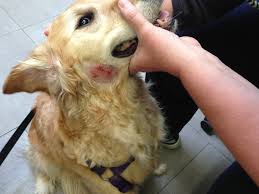“Hotspots” are a familiar summer-time problem for many owners of long-haired dogs. A hotspot is basically a focal area of bacterial dermatitis. It occurs because the bacteria which normally live on the skin- the “normal flora”- are given better than usual conditions in which to grow. Given ideal conditions- at least from the “bacterial point of view”, the normal flora ceases to be controlled by the defence mechanisms of the body, and start to grow out of control. The result is an area of very inflamed, painful skin covered in pus and scabs.
The two things that bacteria like best are warmth and moisture.Both these things are in good supply in an average Sydney summer, especially in the more humid months towards the end of summer or during periods of rain.
The problem may occur in any dog, but it’s most common in long-haired breeds such as Golden Retrievers and Old English Sheepdogs. The reason is that if the hair becomes wet – for example after a swim, a bath, or being caught in a rainstorm – the outside of the coat dries off quickly in the summer heat but the hair inside near the dog’s skin- where the bacteria live – remains moist. Supplied with this bacterial idea of paradise, the little blighters start to reproduce at an incredible speed. Within just a few hours a nasty, suppurating sore can develop. The severity and extent of the hotspot is often complicated by the dog’s long hair: it may take some time for the owner to notice the area of inflammation in the depths of the hair coat, and in the meantime the lesion can spread over a very large distance.


The treatment for hotspots involves the vet doing one or more of the following:
- clipping the affected area free of hair
- bathing with an antibacterial solution and drying the area thoroughly afterwards
- application of a cream containing an antibiotic, an anti-inflammatory and a local anaesthetic
(4) antibiotic tablets and/or injection
(5) anti-inflammatory tablets and/or injection.
A strategy of prevention is a much preferable approach – one which can avoid your dog having to suffer from this painful condition. The following measures should be followed, especially in long-haired dogs, and especially during the summer months:
- Ensure your dog’s coat is very thoroughly towel dried following a bath, swim, or being caught in rain.
- If you see the early signs of a hotspot lesion developing (usually red raised dots on the skin), carefully clip the hair away from the area. It is important to clip beyond the perimeter of the affected region until you can visualise normal skin.
- Clean the area thoroughly with a solution of 1 teaspoon of salt to ½ litre of water, and dry it thoroughly afterwards.
- If your dog has a history of getting hotspots in summer, we can supply you with a cream containing an antibiotic, cortisone and local anaesthetic to apply twice daily.
- If you don’t notice the hotspot lesion soon enough for the above measures to be effective, bring your dog down to see one of our vets as soon as possible; the earlier we can treat the lesions, the less extensive and severe they will be.








